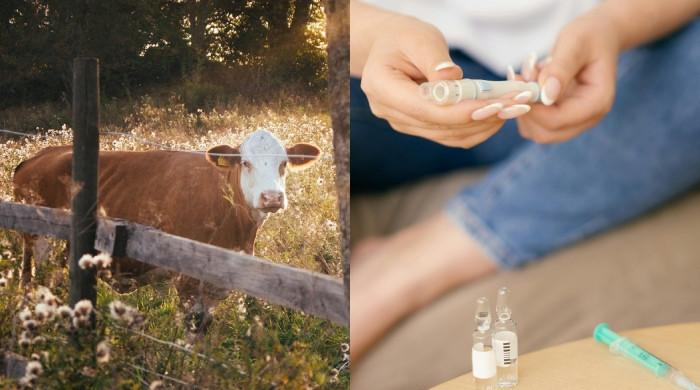[ad_1]

Article content
I love driving around the farm fields at this time of year.
Advertisement 2
Article content
I like to see how they look, how the growing season has gone. I like to take a stab at how many bushels to the acre the barley or wheat will yield, even though I have zero clue how to figure that out.
Article content
I like to watch the combines work, to smell the dust and chaff they kick out, to try to guess what the crop is just by its scent. I like to hear the crickets and grasshoppers at the edges of the ripening grain and watch the hawks circling over the fields.
But it looks like this year, I headed out a little bit too late.

Usually, around now, the fields have hit their peak and are ready for the combines to start chewing away. That, of course, depends a bit on where you are. The dryland farms farther south often start taking crops off by the end of July while farther north, a few of the fields still have patches of green.
Advertisement 3
Article content
And then there are the irrigated fields. With their artificial rain, they can keep growing and filling out their seed heads as long as the sun stays warm enough. But it’s those old, standard barley and wheat crops that I like to see. So that’s what I headed out to check.
But, being over-confident in what I would find, I decided to have a look at a few water bodies first.
I knew most of my favourite sloughs would be dry because, well, they were dry two months ago so they obviously would still be now. So I headed right for the first body of water that I knew I could count on.

Clear Lake, about halfway between Stavely and Carmangay, is kept full throughout the summer by irrigation canals running from farther north in the Little Bow River watershed. Other than the nearby Twin Valley Reservoir, it’s the biggest body of water in the area. And because of that, it is always loaded with birds.
Article content
Advertisement 4
Article content
Especially at this time of year.
Waterfowl — ducks, geese, swans — have had their eggs hatched for a couple of months now and all those fuzzy little babies are pretty much grown up. They look like adults, they walk and swim like adults but, especially the ducks, they haven’t really mastered flying yet so they tend to stay fairly close to where they were hatched.
And there must have been a bunch of them hatched at Clear Lake.

Every little promontory was covered with them. Through my long lens, I could pick out the blue chevrons on the mallards and the grey beaks on the wigeons. Looked to be a few pintails among them, too.
And there were plenty of shorebirds like yellowlegs and killdeers. And avocets. The lovely orange feathers on the adults have mostly faded over the summer so now they are pretty much indistinguishable from their black and white babies.
Advertisement 5
Article content
There were pelicans there and several blue herons, too. Over in the deeper part of the lake in an area sheltered from the wind, a hundred or so Franklin’s gulls were hunting bugs on the water. Half a dozen harriers patrolled the shoreline looking for prey.
I felt a bit sorry for the birds away from the water, though. The young meadowlarks and sparrows were panting in the 32C heat. Same with the baby Swainson’s hawks.

If I’d been out this way a couple weeks ago, away from the lake, I likely would have found plenty to shoot with patches of green and gold among the fields but now, everything looks ready for the combines.
Which was part of the reason I’d waited to come out this way. Even though I was a bit surprised at how ripe all the crops were, I was pretty certain I’d find at least some of them being taken off. But no, I didn’t. Between Nanton and Carmangay, I saw not a single combine working in a field.
Advertisement 6
Article content
But at least I had dry sloughs to play with.
Yeah, I know, I’m maybe a little too enamoured of these patches of alkali and dry algae but I just find them so fascinating. Especially when I’m looking down on them.

Using my little drone to fly over and see them from the air, I can pick out all sorts of interesting patterns in the bright white alkali, mats of desiccated algae and bacterial colonies, things that you don’t necessarily see from the ground. There are always bird and animal tracks around the edges and things like tumbleweeds and bits of sticks and feathers all rimed in whites and blues.
Some of these sloughs are centuries — maybe millennia — old, low spots in the prairie that have water in some years, in others, not. I wonder if anyone has ever pulled a core sample from one of them, drilled down to the glacial till at their lowest levels to see if there are any discernible patterns to the dry and wet periods their muck has recorded.
Advertisement 7
Article content
That would be even more fascinating than their alkali and algae surfaces. Well, to me at least.
Not finding any combine action where I was, I continued on east past Barons and over toward Travers Reservoir. But if I was hoping to find any harvesting over that way, I was about to be disappointed.

Because it was done. With the exception of canola, every field was sheared like a sheep. I found a couple of little patches of standing barley at the edge of one field so I flopped down on the powdery ground to grab what pictures I could but it didn’t amount to much. Now I wished I’d shot the fields over by Clear Lake and the dry sloughs instead of making the dumb assumption that I would find something over here.
But no, there was nothing left to shoot.
Advertisement 8
Article content
At least, not among the fields.
On their edges, though, there were more meadowlarks, flocks of blackbirds, dozens of mourning doves. I found a mulie buck that trotted over and leapt a fence like it was nothing and watched a whitetail doe and her fawns speed away over a low hill.

There was a lone cow grazing on the native prairie by the reservoir and a little cottontail that posed for me close to the dam. The lake was like a mirror, the wind from earlier in the day now completely still, and I could make out a trio of cormorants flying low along its surface though they were barely visible through the smoke that had settled into the valley.
Over at Williams Lake, the next reservoir down the chain, the conditions were much the same but there was a bit less smoke. Pelicans and gulls were preening on a gravel bar off shore and I could see the big wind turbines on the ridge behind them looking tall and ghostly through the smoke. Young ducks and geese thronged the shoreline and I found a couple of mule deer families taking advantage of the relative cool of the cattails and tall willows by the bays.
Advertisement 9
Article content
Red samphire absolutely glowed in the late-day sunshine while bees and ants and moths thronged the wild sunflowers along the road. It was so still I could hear people at the little campground more than a kilometre away across the water, their voices mixing with the sounds of ducks and geese and, I swear, a loon.


I could have just parked and sweated there in the heat until the sun went down but one of the reasons that I’d headed out late in the day — besides the crops and combines — was because I wanted to shoot the moonrise. Things were looking iffy for that, though, with the forest fire smoke in the air and what looked like a bank of clouds to the east.
So, with the sun just a couple of hand-widths above the horizon, I started heading west toward a tall ridge by Little Bow Park. And that’s when I finally found some working combines.
Advertisement 10
Article content
They were gnawing away at a really patchy field of canola, picking up what they could and spewing chaff into the 30C air, leaving dusty contrails behind them. Quickly, I shot some pictures from ground level and then launched the little drone to see them from above.
From a few metres up, the crop looked pretty dire and the combines didn’t have much to work with. I love to see dried-up sloughs. Don’t much like seeing dried-up fields.

I raced westward now, watching my mirrors for any sign of the moon rising as I went. At the ridge I was aiming for I found a couple of big mule deer bucks wandering through a dusty field of canola — much more lush than the one with the combines — just as the sun went behind a bank of clouds to the west. Keeping an eye on the eastern horizon as I shot the mulies, I waited for the moon to rise until the sun finally set.
Advertisement 11
Article content
OK, add another little disappointment to the day. The moon should have cleared the eastern horizon shortly before the sun disappeared to the west but, thanks to the cloud bank, it never showed. It was there, of course, I just couldn’t see it.
I kept watching for it as I headed farther west and watching for combines, too. It finally found a gap in the clouds when I was taking a picture of the one working combine I’d been able to find in the dusk. I tried, but I just couldn’t get the two to line up.
And that was my day. Some birds, some deer, some fields, some harvest. Not a great day but not the worst, either. No matter, I just love driving around among the fields and checking the crops anyway. But, I really should have done it two weeks ago.
Oh well, it’s kinda like farming.
There’s always next year.

Article content
[ad_2]
Source link














































Comments
Postmedia is committed to maintaining a lively but civil forum for discussion and encourage all readers to share their views on our articles. Comments may take up to an hour for moderation before appearing on the site. We ask you to keep your comments relevant and respectful. We have enabled email notifications—you will now receive an email if you receive a reply to your comment, there is an update to a comment thread you follow or if a user you follow comments. Visit our Community Guidelines for more information and details on how to adjust your email settings.
Join the Conversation